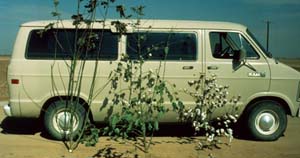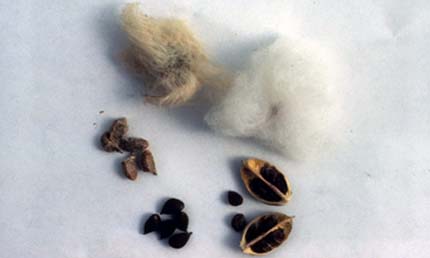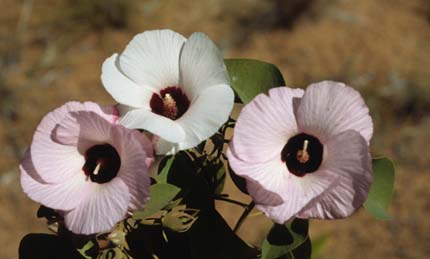5585 Guilford Road • Madison, WI 53711-5801 • 608-273-8080 • Fax 608-273-2021
www.agronomy.org
Twitter | Facebook
NEWS RELEASE
Contact: Hanna Jeske, Associate Director of Marketing and Brand Strategy, 608-268-3972, hjeske@sciencesocieties.org
Not your grandfather’s cotton
Feb. 3, 2016 - Ah, soft, smooth cotton. We love it in our sheets, our tablecloths, and luxurious cotton shirts. But did you know that different cotton species can grow as rugged trees in Australia or Central America? Or as a wild shrub in the southern United States? And that the cotton plant has quite the history of genetics to tell?
From transoceanic travels to inter-species cross-breedings, cotton’s story is one of plant and seed survival, adaptation, and human cultivation. What started as a naturally tough, unspinnable fiber has been transformed into something most folks adore for its soft, comforting feel.
 Humans have been using cotton for more than 6,000 years. (As a reference, synthetic fibers like polyester weren’t created until after World War I.) Cultivation – farming it and trying to improve the crop yield and properties – started at least 3,000 years ago. Many of us studied Eli Whitney and his invention of the cotton gin in 1794 as part of our history classes. But rarely do we think about the science behind cotton itself.
Humans have been using cotton for more than 6,000 years. (As a reference, synthetic fibers like polyester weren’t created until after World War I.) Cultivation – farming it and trying to improve the crop yield and properties – started at least 3,000 years ago. Many of us studied Eli Whitney and his invention of the cotton gin in 1794 as part of our history classes. But rarely do we think about the science behind cotton itself.
In the United States, cotton is a $5 billion dollar industry. Specialized crop scientists study its agronomic and economic importance. The Crop Science Society of America even held a symposium about cotton at their annual meeting. They also released an updated book about cotton in 2015.
Jonathan Wendel, Iowa State University, is a leading researcher in the field. He says there is much to learn about the “unique origin and diversification of the cotton genus, its basic plant biology, and its properties as a crop plant.”

Cotton started its evolution long before humans got involved in the picture. “The four species of cotton that are cultivated originated from geographically far-flung locations – India, Asia, Africa, and Central and South America,” Wendel says. “All of the wild species have short fibers that are not good for spinning or use. But in one particular group of African wild species, some slightly longer fibers naturally evolved. Those fibers actually have mechanical properties that one could make primitive cloth from. This happened only once, in this African group.”
Somehow – scientists can only speculate about how – the seeds dispersed across continents, and crossbreeding occurred.
“In the case of cotton, its seeds retain a little buoyancy for up to a couple of months in some circumstances,” says Wendel, suggesting that seeds could cross the ocean on their own. “I suspect that some form of natural rafting has been involved--floating mats of coconut debris, for example. The seeds tolerate saltwater well, and retain their fertility.”
At first, nature took cross-pollination and the evolution of cotton into its own hands. Once a seed was dispersed, and the new cotton plant grew, cross-pollination happened naturally. Many species self-pollinate as well, a typical story across the plant kingdom.
“Plants from islands are more likely to be self-pollinating than are mainland plants, because they have a harder time finding a ‘dance partner’,” says Wendel.
 After the initial dispersal, humans got in the game. “Four different groups of ancient cultures, all likely 5,000 years ago or more, each independently brought wild cotton into cultivation. They bred some crummy looking perennial ancestors into annualized plants with abundant long, strong, fine, white fiber,” Wendel says.
After the initial dispersal, humans got in the game. “Four different groups of ancient cultures, all likely 5,000 years ago or more, each independently brought wild cotton into cultivation. They bred some crummy looking perennial ancestors into annualized plants with abundant long, strong, fine, white fiber,” Wendel says.
Even though Wendel has studied cotton for years, he finds this genetic history “totally amazing. From all this research, you can see that there is only one origin of spinnable fiber!”
To match cotton’s genetic past, Wendel says the future of cotton also lies in its genes. “Fewer diseases, better water use efficiency, higher yield, more pest resistance,” says Wendel. “Science magazine just announced their 2015 ‘breakthrough of the year’, which was CRISPR genome editing. Wait until we can grab ahold of that for cotton!”